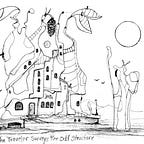How Strong Towns Principles Relate to Sioux Falls — Stifling Land Values
- based on “Strong Towns — A Bottom-Up Revolution To Rebuild American Prosperity” by Charles L. Marohn, Jr.
“Auto-oriented, suburban development was an attempt to address many problems with the city. One of the most pernicious was the stifling nature of high land values, the inevitable result of a maturing city.” — Chuck Marohn
As a traditional city matures land values go up because the city is a desirable place to live and do business. The increase in land values provides the city with a stable source of revenue. This revenue is used to provide fire and police protection, maintain infrastructure and offer amenities like museums and libraries. But the higher land values also make it difficult for people of lesser income to live and start a business in the city. Marohn describes a mature city as “valuable land surrounded by cheap land, wealthy people surrounded by poor people”. This is a natural result of incremental development creating value in the confines of a city.
“Gentrification” refers to for-profit organizations following their mandate to maximize profit by building developments in areas of rising land values that only wealthy people can afford. This is an extreme case of the natural renewal process in a city. Cities need to guard against uncontrolled gentrification because it can lead to mass homelessness as is happening in Oakland and other places right now. People can no longer afford to live in the neighborhoods they had been living in for years. There are ways to guard against gentrification which we will discuss in future articles.
The use of the sprawling, suburban model of development after WWII seemed like an answer to high land values. It was — but it had the unintended consequence of lowering land values all over the city including in the stable economic base of the cities’ cores. The center of cities like Detroit began to deteriorate which destroyed the land values that once made the city stable. There was now not enough land and tax value to support all the infrastructure that had been built as part of the suburban development model.
Cities no longer had the land value necessary for traditional redevelopment and renewal. Older areas in places like Sioux Falls began to decline. Many old buildings were torn down in the name of urban renewal because there wasn’t enough value to allow for redevelopment. In Sioux Falls we have been lucky that many grand buildings have survived although it took heroic efforts by dedicated citizens to save buildings like the Old Courthouse Museum, the Washington Pavilion and the Pettigrew House. Unfortunately, some older residential areas have not fared as well. Our challenge is to restore the renewal mechanism in those older neighborhoods without destroying the neighborhoods themselves and while still maintaining affordable housing.
The modern development model builds developments all at once to a finished state. There is nothing for the value of the development to do but to go down over time. There is no natural renewal mechanism since values go down instead of increasing as in the case of incremental development models. Modern development models treat city building as a complicated problem instead of a complex problem involving people, neighborhoods and relationships.
Want to check out the book? Buy it here.
